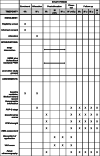Effectiveness of intravaginal electrical stimulation combined with electromyography biofeedback-mediated pelvic floor muscle training for postpartum symptomatic pelvic organ prolapse: protocol for the PROSPECT randomized trial
- PMID: 35139910
- PMCID: PMC8826656
- DOI: 10.1186/s13063-022-06051-z
Effectiveness of intravaginal electrical stimulation combined with electromyography biofeedback-mediated pelvic floor muscle training for postpartum symptomatic pelvic organ prolapse: protocol for the PROSPECT randomized trial
Abstract
Background: Pelvic organ prolapse (POP) is seen in up to 30-70% of women presenting for routine gynecology care and 10% of women suffering from bothersome POP symptoms. Vaginal childbirth is one of the most prominent contributing factors for POP. Pelvic muscle training (PFMT) is considered effective to improve mild to moderate POP symptoms. In addition, higher-intensity, supervised PFMT aided by biofeedback and electrical stimulation may confer greater benefit. However, the long-term efficacy of the PFMT combined with electromyography biofeedback is unknown, which indicates the need for further evidence.
Methods: This multicenter randomized controlled trial compares the effectiveness and cost-effectiveness of conventional PFMT versus biofeedback-mediated PFMT plus neuromuscular electrical stimulation (NMES) for postpartum symptomatic POP women. The primary outcome is the proportion of patients with the improvement of at least one POP-Q stage at 36 months after randomization. The primary economic outcome measure is incremental cost per quality-adjusted life year at 36 months. Two hundred seventy-four women from four outpatient medical centers are randomized and followed up with pelvic floor examination, questionnaires, and pelvic ultrasonography imaging. All participants are arranged for three appointments over 12 weeks. NMES and electromyography biofeedback via intravaginal probe are added to PFMT for participants in the biofeedback-mediated PFMT group. Group allocation could not be blinded from participants and healthcare staff that deliver intervention but remain masked from medical staff that carry out PFM assessment. An intention-to-treat analysis of the primary outcome will estimate the difference of the proportion of POP-Q stage improvement between the trial groups right after the intervention, and during the follow-up until 36 months, using the chi-square test and multilevel mixed models respectively. A logistic regression analysis was used for adjusting for important baseline variables that are unbalanced.
Discussion: The trial results will provide evidence of the effectiveness of electromyography biofeedback-mediated PFMT in improving women's POP-Q staging, quality of life, and cost-effectiveness.
Trial registration: CCTR Registry ChiCTR210002171917 . Registered on March 6, 2019.
Keywords: Biofeedback; Economic evaluation; Electrical stimulation; Pelvic floor muscle; Prolapse; Quality of life.
© 2022. The Author(s).
Conflict of interest statement
The authors declare that they have no competing interests.
Figures
Similar articles
-
Effectiveness and cost-effectiveness of basic versus biofeedback-mediated intensive pelvic floor muscle training for female stress or mixed urinary incontinence: protocol for the OPAL randomised trial.BMJ Open. 2019 Feb 19;9(2):e024153. doi: 10.1136/bmjopen-2018-024153. BMJ Open. 2019. PMID: 30782895 Free PMC article.
-
Effect of structured pelvic floor muscle training on pelvic floor muscle contraction and treatment of pelvic organ prolapse in postpartum women: ultrasound and clinical evaluations.Arch Gynecol Obstet. 2024 May;309(5):2177-2182. doi: 10.1007/s00404-023-07226-y. Epub 2023 Sep 27. Arch Gynecol Obstet. 2024. PMID: 37755534
-
Basic versus biofeedback-mediated intensive pelvic floor muscle training for women with urinary incontinence: the OPAL RCT.Health Technol Assess. 2020 Dec;24(70):1-144. doi: 10.3310/hta24700. Health Technol Assess. 2020. PMID: 33289476 Free PMC article. Clinical Trial.
-
Conservative Interventions for Urinary Incontinence on Postpartum Women: A Systematic Review and Meta-Analysis.J Midwifery Womens Health. 2024 Sep-Oct;69(5):663-671. doi: 10.1111/jmwh.13653. Epub 2024 May 28. J Midwifery Womens Health. 2024. PMID: 38807257
-
Vaginal Pessaries for Pelvic Organ Prolapse or Stress Urinary Incontinence: A Health Technology Assessment.Ont Health Technol Assess Ser. 2021 May 6;21(3):1-155. eCollection 2021. Ont Health Technol Assess Ser. 2021. PMID: 34055111 Free PMC article.
Cited by
-
Effect of Pelvic Floor Workout on Pelvic Floor Muscle Function Recovery of Postpartum Women: Protocol for a Randomized Controlled Trial.Int J Environ Res Public Health. 2022 Sep 4;19(17):11073. doi: 10.3390/ijerph191711073. Int J Environ Res Public Health. 2022. PMID: 36078788 Free PMC article.
-
Two year follow-up and comparison of pelvic floor muscle electromyography after first vaginal delivery with and without episiotomy and its correlation with urinary incontinence: A prospective cohort study.Acta Obstet Gynecol Scand. 2023 Feb;102(2):200-208. doi: 10.1111/aogs.14487. Epub 2022 Nov 29. Acta Obstet Gynecol Scand. 2023. PMID: 36448197 Free PMC article.
References
Publication types
MeSH terms
Grants and funding
LinkOut - more resources
Full Text Sources
Medical



